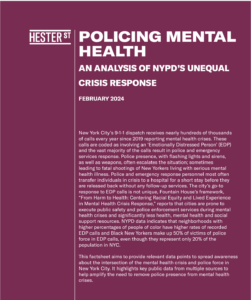In 2021, with funding from the van Ameringen Foundation, Hester Street (HST) partnered with the Brooklyn Movement Center (BMC) and Communities United for Police Reform (CPR) to lead the NYPD Out of Mental Health initiative, aimed at establishing a community-first blueprint for addressing mental health issues and crises in Central Brooklyn.
In collaboration with BMC and CPR, the Hester Street team conducted data analysis to build an interactive map that encourages a transformative model of mental health care through avenues that move away from the intervention of law enforcement. We produced a visualized dataset that provides information on mental health community care facilities and resources, police interactions, EMS responses (with and without NYPD responses), and various other demographic and socioeconomic indicators. This dataset can be used by organizers, policy advocates, community-based organizations, and other activists working on alternatives to policing in crisis-response and longer-term mental health care. In March 2023, we shared a report with our partners on the NYPD Out of Mental Health initiative with community-first mental health recommendations to support CPR’s advocacy around legislative reform regarding mental health care.
In 2022, Hester Street received a grant from the Robert Wood Johnson Foundation to continue our work with BMC and CPR and create a data-based factsheet with analysis supporting comprehensive mental health education and policy advocacy. The factsheet presents public data and high-level analysis to illustrate the unequal crisis response from the NYPD in communities of color.
Beginning in January 2023, our team engaged select stakeholders to understand how police response to mental health crises disproportionately affects communities of color in NYC. We worked with Just City, a Memphis data analysis firm invested in devising alternative forms of community policing, to create a static infosheet which frames the mismatch between police intervention and community mental health needs and builds on the recommendations from the NYPD Out of Mental Health report.
In February 2024, HST released the “Policing Mental Health” factsheet highlighting key public health data to help amplify the need to remove police presence from mental health crises. The factsheet identifies that over-policing often begins as early as elementary or middle school for Black and Latinx youth. NYPD data further indicates that neighborhoods with higher percentages of people of color have higher rates of recorded Emotionally Distressed Person (EDP) calls and Black New Yorkers make up 50% of victims of police force in EDP calls, even though they represent only 20% of the population in NYC. However, data from the Department of Health and Mental Hygiene (DOHMH) and NYPD points to the overall impact preventative health care services and access can create for the wellness of communities of color, decreasing the likelihood of EDP calls for those who receive mental health counseling.

